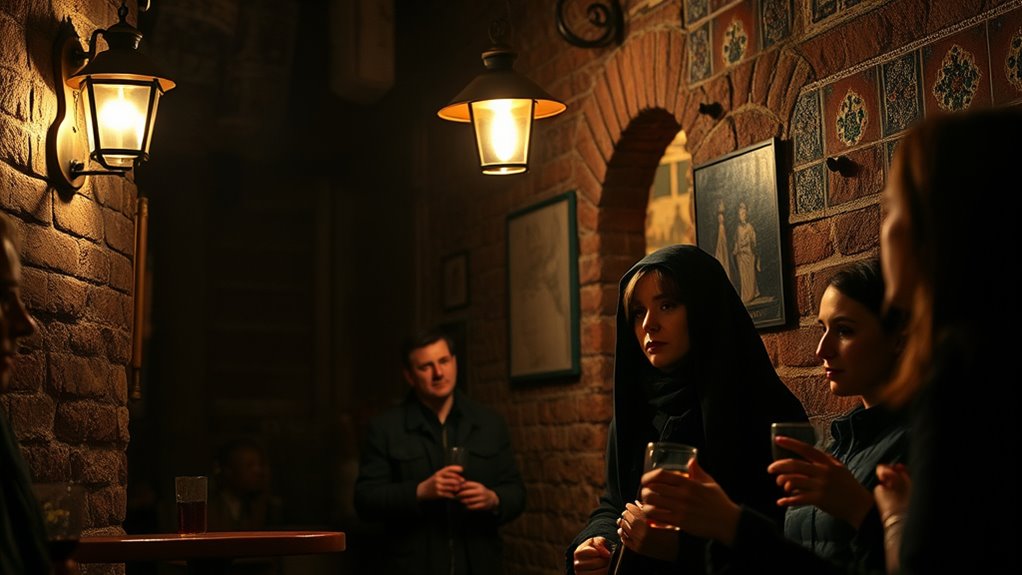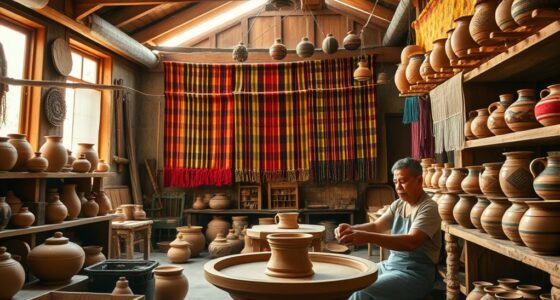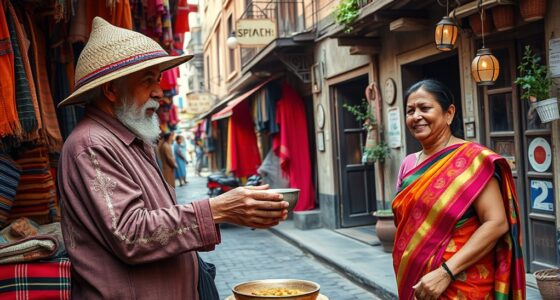Fado in Lisbon is a soulful, emotional music that captures Portugal’s heart and history. Originating in early 19th-century neighborhoods like Alfama and Mouraria, it combines Moorish melodies, African chants, and Iberian traditions. You’ll experience expressive singing, guitar melodies, and heartfelt lyrics about longing and love. Visiting historic venues or lively taverns lets you immerse yourself in its powerful atmosphere. To discover more about Fado’s roots and vibrant present, keep exploring this mesmerizing musical tradition.
Key Takeaways
- Experience authentic Fado performances in historic Lisbon neighborhoods like Alfama and Mouraria at venues such as Clube de Fado and Sr. Vinho.
- Discover the emotional depth of Fado through traditional instruments like the Portuguese guitar, reflecting Lisbon’s multicultural roots.
- Learn about Fado’s origins from working-class neighborhoods, evolving into a symbol of Portuguese identity and cultural pride.
- Attend Fado festivals and cultural events that showcase both traditional and contemporary interpretations of this soulful genre.
- Engage with Fado’s rich history, from legendary singers like Maria Severa and Amália Rodrigues to modern fusion styles.
The Origins of Fado in Lisbon
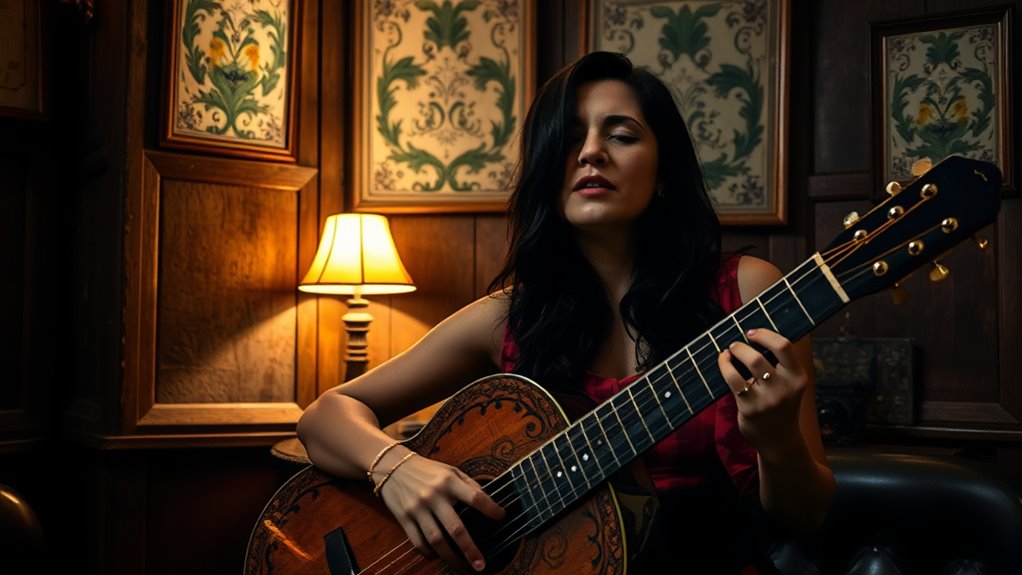
Fado in Lisbon began taking shape in the early 19th century, emerging from the city’s bohemian neighborhoods like Bairro Alto, Mouraria, and Alfama. You’ll find that Fado’s poetic lyrics reflect deep emotions, often expressing longing, love, and sorrow. Its emotional expression resonates with listeners, capturing the struggles and hopes of Lisbon’s working class, sailors, and courtesans. Early performers, like Maria Severa, helped popularize this genre, turning it from dance into a vocal-centric art form. As Fado evolved, it retained its heartfelt lyrics and expressive power, becoming a symbol of Portuguese identity. The genre’s roots are intertwined with the diverse cultural influences of Lisbon’s historic quarters, shaping a musical style that continues to evoke profound feelings today. Additionally, the emotional intensity of Fado performances is often enhanced by the traditional Portuguese guitar, which adds a distinctive timbre to the music.
Influences Shaping Fado’s Sound and Style

The sound and style of fado are shaped by Lisbon’s rich history as a melting pot of cultures and traditions. Moorish melodies and maritime themes blend with Western harmonic influences to create its distinctive character. By understanding these diverse musical roots, you can better appreciate fado’s emotional depth and unique sound. Historical exchanges with various civilizations have infused Lisbon’s musical landscape with a variety of elements that continue to influence fado today. Additionally, the cultural diversity of Lisbon’s population has contributed to the evolution of fado, making it a reflection of the city’s multifaceted heritage.
Historical Melting Pot
Lisbon’s atmospheric neighborhoods, such as Mouraria and Alfama, served as vibrant crossroads where diverse cultures blended, shaping the unique sound and style of fado. The genre’s origins reflect a cultural melting pot, influenced by Moorish chants, African rhythms, and Brazilian melodies. Early performances by sailors, courtesans, and bohemians infused fado’s social symbolism and lyrical poetry with themes of marginality and urban life. Notable figures like Maria Severa, of mixed racial backgrounds, helped popularize fado’s expressive voice. The genre’s evolution was driven by these diverse influences, creating a musical tapestry that embodies Lisbon’s cultural diversity. Fado’s history as a social and artistic expression highlights how these influences shaped its soulful sound and enduring significance.
| Influence Type | Origin/Impact |
|---|---|
| Moorish | Melodic patterns and rhythms |
| African | Rhythms and vocal stylings |
| Brazilian | Melodic and lyrical inspiration |
| Cultural Exchange | Ethnic diversity in Lisbon |
| Social Marginality | Fado’s symbolic themes |
Musical Traditions Influence
Various musical styles have shaped the distinctive sound of fado over centuries. The instrumental evolution reflects influences from classical compositions, with strings and orchestral elements enriching performances today. Traditional fado do marinheiro laid the foundation, emphasizing melancholic melodies and expressive vocals. Brazilian “lundum” and African chants introduced rhythmic and tonal nuances, adding depth to fado’s sound. Lyrical themes often revolve around saudade, longing, and social struggles, echoing medieval “cantigas de amigo” and Moorish melodies. These influences blend seamlessly, creating a complex and emotionally charged genre. Over time, fado’s style has diversified, from the traditional Fado Castiço to more aristocratic and bohemian forms, yet its core remains rooted in a rich tapestry of musical traditions that continue to shape its unique character. The ongoing musical evolution highlights how fado continues to adapt while preserving its emotional and cultural essence.
Pioneers Who Defined Fado’s Spirit

Pioneers have shaped the authentic spirit of fado, transforming it from its humble, marginalized origins into a profound expression of Portuguese culture. Maria Severa Onofriana, known as Severa, is often considered Lisbon’s first professional fado singer, helping introduce the genre to aristocratic salons through her affair with the Count of Vimioso. These early performers, mainly from urban working-class backgrounds, laid the foundation for Fado’s regional variations across Portugal. Icons like Amália Rodrigues and Alfredo Marceneiro elevated fado’s emotional depth, blending poetic lyrics and innovative styles. Their contributions not only defined fado’s soulful sound but also influenced contemporary music, inspiring new generations to explore and evolve the genre, ensuring its lasting cultural significance. Their legacy continues to influence modern artists, keeping the tradition alive and relevant today.
Furthermore, the development of cultural intelligence among performers and audiences has helped preserve the genre’s authenticity while allowing it to adapt to modern contexts.
The Cultural Roots of Lisbon’s Melancholic Melodies

The soulful melodies of fado are deeply rooted in Lisbon’s rich cultural tapestry, reflecting centuries of historical influences and social changes. Its origins blend diverse elements, from Moorish chants and medieval cantigas to influences brought by sailors and Afro-Brazilian traditions. Lisbon’s multicultural melting pot shaped fado’s melancholic themes, which express love, loss, and longing. Today, contemporary fusion and global influences continue to enrich fado, blending traditional instruments like the Portuguese guitar with modern arrangements, from string quartets to orchestras. This evolution allows fado to resonate beyond its roots, embracing new sounds while preserving its emotional core. The genre’s roots are rooted in folk tradition, which have helped preserve its authentic emotional expression despite evolving musical styles. Furthermore, the ongoing cultural exchanges ensure that fado remains a living art form capable of adapting to contemporary tastes.
The Evolution of Fado Through the Ages
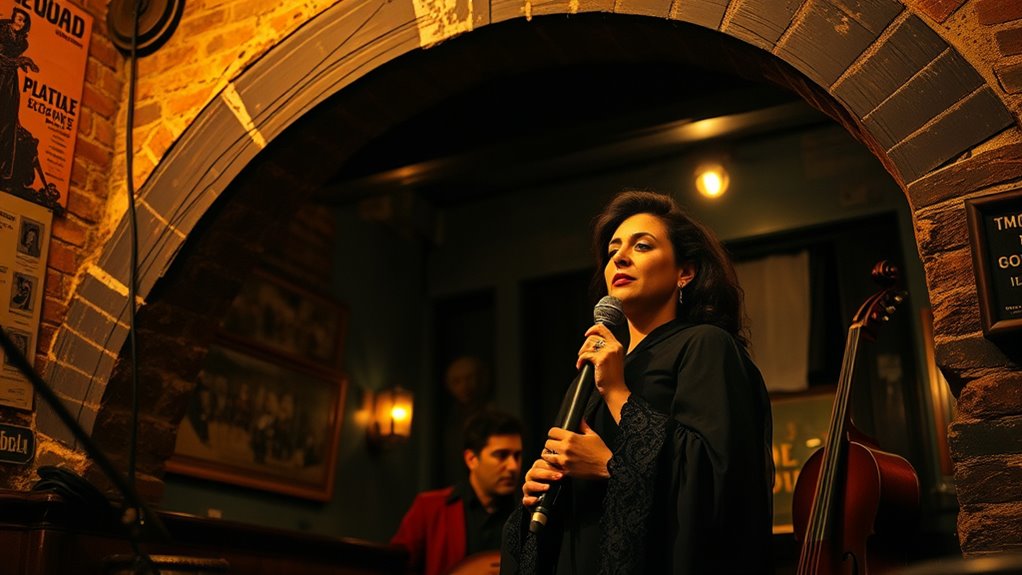
As Fado evolved from its humble beginnings in Lisbon’s working-class neighborhoods, it absorbed influences from various social and cultural traditions, shaping its distinct sound. You’ll see how modern interpretations and revivals have kept the genre relevant, blending traditional themes with new styles. This ongoing transformation highlights Fado’s enduring ability to reflect Portugal’s changing identity. Its origins date back to the early 19th century, and throughout the years, the genre has continually adapted to the social and cultural shifts in Portuguese society. The genre’s musical roots demonstrate a deep connection to Portugal’s historical and cultural landscape, which continues to influence contemporary Fado artists.
Origins and Early Influences
Fado began to take shape in Lisbon’s bohemian neighborhoods during the early 19th century, emerging from a vibrant mix of cultural influences. Its roots trace to diverse traditions like Afro-Brazilian rhythms, Moorish chants, and Iberian melodies, blending into an emotional musical language. Early fadistas performed in taverns, often involving spontaneous singing, the use of simple Fado instruments like the guitarra and viola, and lively Fado dance. These elements reflected the social realities of marginalized communities, especially sailors and courtesans. The genre’s evolution saw a shift from dance-based performances to a focus on powerful vocals. This early period established the foundation for Fado’s distinctive sound, characterized by heartfelt expression and cultural fusion. Cultural influences played a crucial role in shaping its unique emotional tone.
Modern Interpretations and Revival
Modern interpretations and revival efforts have transformed Fado into a vibrant, evolving genre that embraces innovation while honoring tradition. Contemporary fusion allows artists to blend jazz, classical, and rock elements, broadening Fado’s appeal beyond Lisbon’s roots and reaching global audiences. Despite these experiments, musicians remain committed to preserving the genre’s core melancholic soul and saudade spirit. Artist innovation plays an essential role, with performers reinterpreting traditional themes and expanding sonic textures—sometimes incorporating orchestras or string quartets—without losing the emotional depth. Institutional support, like the Fado Museum and music schools, helps nurture this evolution, ensuring Fado stays relevant and alive. This harmony of tradition and modernity keeps Fado’s cultural relevance intact, attracting younger generations while safeguarding its soulful essence. Additionally, musical preservation initiatives foster the transmission of Fado’s unique cultural and emotional heritage to new audiences.
Distinctive Styles: Lisbon vs. Coimbra
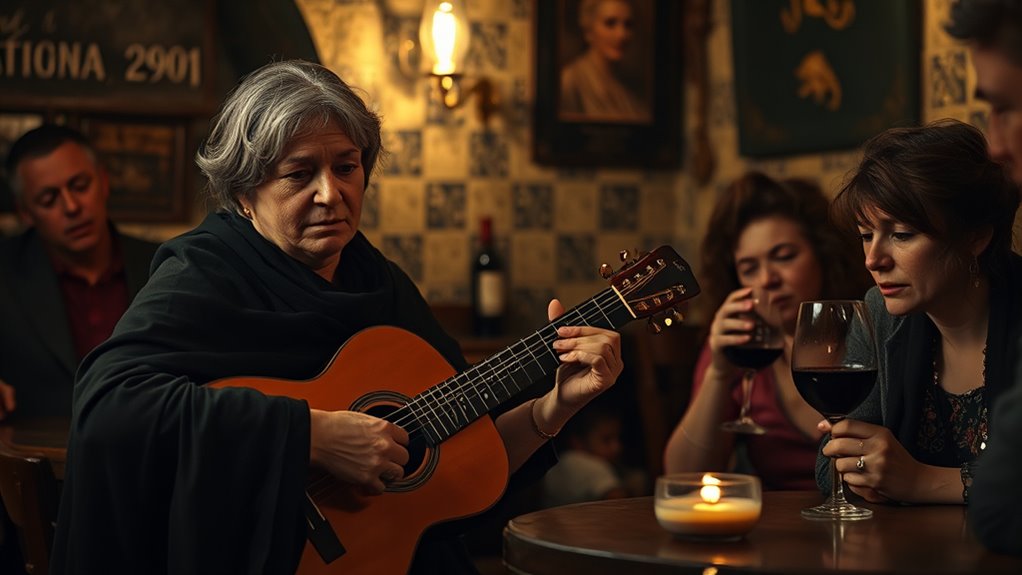
Lisbon and Coimbra each develop their unique takes on Fado, shaped by their distinct cultural and social backgrounds. Lisbon Fado reflects urban life, with emotive singing and lively Fado instrumentation featuring the Portuguese guitar Lisboa, known for its bright, agile sound. The Fado choreography is expressive, often improvising with guitar techniques that respond to the singer’s emotions. In contrast, Coimbra Fado carries a more formal, poetic tradition rooted in academic and serenade culture. Its instrumentation uses the Portuguese guitar Coimbra, producing a deeper, resonant tone, with precise chordal accompaniment. The Fado choreography in Coimbra is restrained and solemn, emphasizing reverence. While Lisbon’s style emphasizes emotional intensity and improvisation, Coimbra focuses on poetic lyrics, classical presentation, and respectful audience interaction. Additionally, the distinctive musical instruments play a crucial role in defining each style’s unique sound and cultural expression.
Fado Venues: The Heartbeat of Lisbon’s Music Scene

You can’t truly experience Fado in Lisbon without visiting its iconic taverns, where the music comes alive in authentic settings. These venues offer more than just performances; they provide a deep cultural connection to the city’s musical roots. Each space captures the heart of Lisbon’s Fado scene, making your experience unforgettable. Engaging with live music in these traditional venues allows visitors to appreciate the cultural significance and emotional depth that define Fado.
Iconic Fado Taverns
Some of the most iconic Fado taverns in Lisbon have become cherished landmarks that preserve the city’s musical soul. These venues, like Café Luso and Clube de Fado, are steeped in history, hosting legendary artists and showcasing authentic Fado nights. They provide a cozy ambiance where you can experience Fado fashion—traditional attire often seen on performers—and feel the spirit of Fado festivals, which celebrate this soulful genre. Whether you prefer the intimate setting of A Severa or the prestigious atmosphere at Sr. Vinho, each tavern offers a unique atmosphere. These venues keep Lisbon’s Fado tradition alive, blending history, music, and cuisine into an unforgettable cultural experience.
| Venue | Atmosphere | Notable Features |
|---|---|---|
| Café Luso | Historic, lively | Longstanding tradition, Fado fashion |
| Clube de Fado | Elegant, prestigious | Top artists, dining options |
| A Severa | Intimate, warm | Family-run, authentic vibe |
| Sr. Vinho | Cozy, respected | Consistent performances |
| Parreirinha de Alfama | Traditional, charming | Oldest, traditional setting |
Authentic Cultural Experiences
Have you ever wondered where you can truly feel the soul of Portuguese music? Fado venues are the heart of Lisbon’s authentic cultural experiences, where Fado’s emotional depth is vividly conveyed. These venues, often in Alfama and Mouraria, blend live performances with dining, immersing you in Portuguese traditions and lifestyle. As you listen, you’ll notice Fado inspired visual art displayed around, enriching your understanding of its cultural significance. Many venues serve as hubs for emerging talent, ensuring the genre’s evolution while respecting its roots. Visiting these spaces, you’re not just an observer but part of a living tradition, where community and history come alive through music, art, and shared experience. It’s a genuine way to connect deeply with Lisbon’s soulful sound, especially when you experience the live music atmosphere that truly captures the genre’s essence.
The Role of Women in Fado’s History

Women have played a pivotal role in shaping the history of fado, from its origins in Lisbon’s bohemian neighborhoods to its status as a national symbol. They contributed to Fado’s poetic lyrics, capturing themes of longing, love, and sorrow that define the genre’s emotional depth. Pioneers like Maria Severa Onofriana helped popularize fado among different social classes, bridging gaps through their powerful voices. Later, artists like Amália Rodrigues expanded its reach internationally, elevating women as icons of Portugal’s musical heritage. Their performances, often wearing traditional attire, embodied the soulful spirit of Lisbon’s streets. Female fadistas continue to influence the genre today, maintaining Fado’s emotional depth while inspiring new generations. Their legacy underscores women’s essential role in Fado’s enduring cultural significance. Additionally, their musical influence has helped preserve and evolve the genre’s traditional sound, ensuring its relevance for future audiences.
Fado’s Place in Portuguese Identity and Heritage
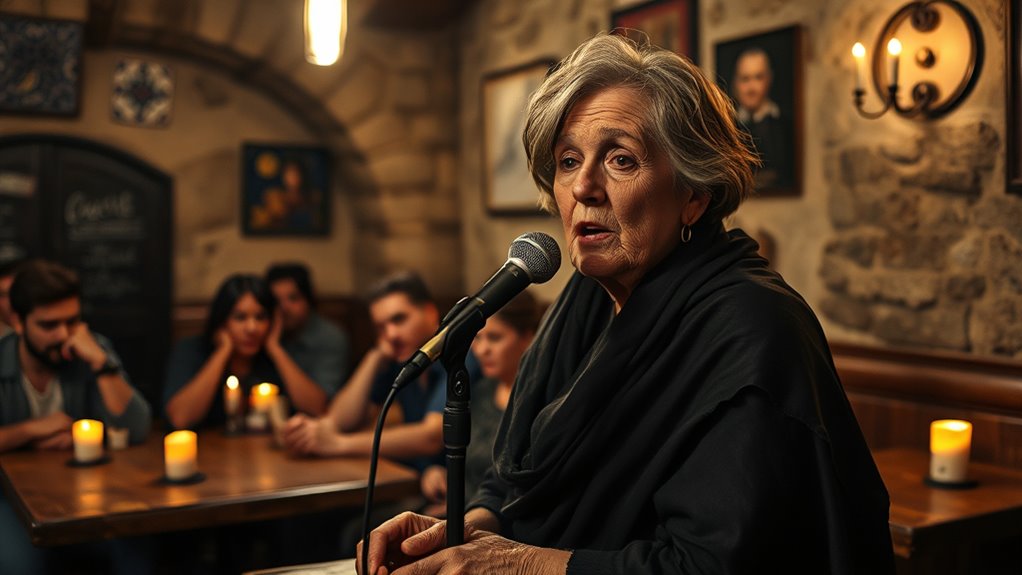
Fado holds a central place in Portuguese identity, embodying the nation’s collective emotions and cultural roots. Its spiritual symbolism reflects Portugal’s deep connection to themes of fate, longing, and nostalgia, resonating through every heartfelt performance. Fado’s lyrical poetry expresses profound human experiences, capturing feelings of saudade that define the Portuguese soul. Recognized as a cultural icon, it’s inscribed on UNESCO’s Intangible Cultural Heritage List, symbolizing national pride. Performed in small Fado houses and across communities, it preserves traditional music and poetry, passing them through generations. Its influence extends beyond borders, fostering cross-cultural exchange and strengthening Portugal’s global cultural identity. Fado’s enduring presence continues to inspire a sense of belonging and pride among the Portuguese people.
Experiencing Fado Today: Traditions and Innovations
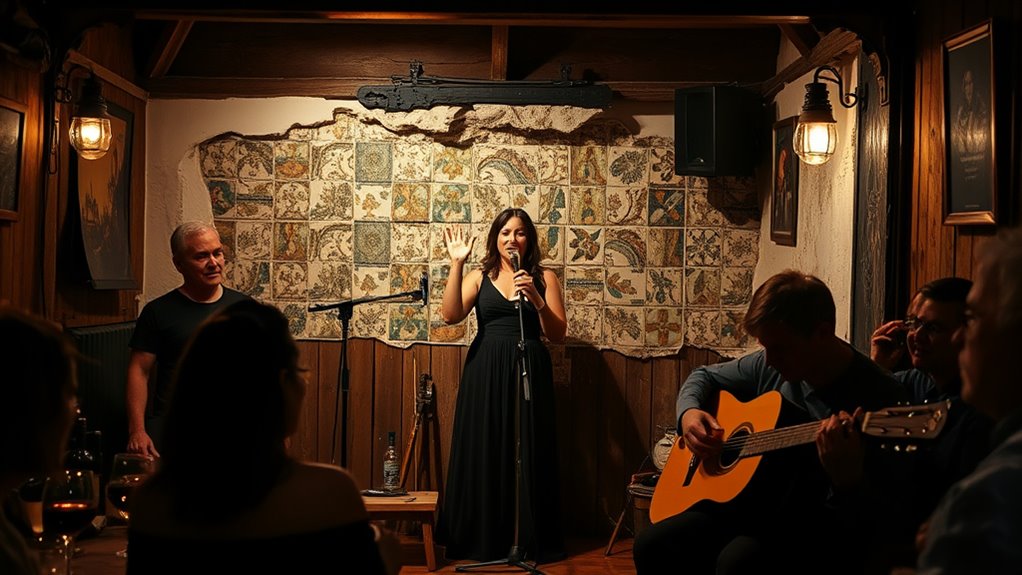
In Lisbon today, experiencing Fado blends tradition with innovation, offering a dynamic cultural landscape for both locals and visitors. You’ll find authentic performances in historic neighborhoods like Alfama, Bairro Alto, and Mouraria, where venues such as A Severa keep the spirit alive by mixing past and present styles. Many Fado houses enhance the experience with traditional Portuguese gastronomy, creating a rich sensory immersion. Modern venues and emerging artists push boundaries, experimenting with fusion genres like jazz, pop, and world music, reflecting urban realities and social themes. Festivals like Caixa Alfama celebrate Fado’s evolution, combining performances, workshops, and cultural storytelling. Whether in traditional houses or contemporary spaces, the emotional depth of Fado remains central, connecting its soulful roots with new innovations that resonate across Lisbon’s vibrant urban landscape. Cultural influences continue to shape the modern expressions of Fado, blending traditional elements with contemporary sounds and themes.
Frequently Asked Questions
How Did Fado Influence Other Portuguese Musical Genres Historically?
You see, fado shaped Portugal’s musical evolution by influencing various genres through its emotive themes and expressive styles. Its genre blending of traditional melodies with contemporary sounds inspired new regional styles like Coimbra fado and folk music. As you explore Portuguese music, you’ll notice how fado’s vocal techniques and melancholic tone deepen lyrical storytelling, making it a cornerstone that connects past traditions with modern musical innovation.
What Are the Regional Differences Within Lisbon’s Fado Performances?
You’ll notice that neighborhood styles deeply influence Lisbon’s fado performances. In Alfama, performances are emotional and vibrant, reflecting its historic roots. Mouraria’s multicultural vibe brings diverse musical influences, adding unique performance nuances. Bairro Alto offers a more informal, spontaneous experience, emphasizing authenticity. These regional differences shape each performance’s atmosphere, making each fado experience in Lisbon distinct and rich, rooted in neighborhood character and tradition.
How Has Fado Been Integrated Into Modern Portuguese Popular Culture?
Fado has truly become a cultural phenomenon, shaping modern Portuguese identity. You’ll notice it in fado-inspired fashion, blending traditional styles with contemporary trends. Modern festivals celebrate this soulful music, attracting diverse audiences and making Fado a staple of pop culture. By merging old and new, you experience how Fado’s emotional depth continues to influence everything from fashion to festivals, keeping Portugal’s heart beating loudly in today’s vibrant cultural scene.
Are There Specific Rituals or Traditions Associated With Fado Performances?
During a Fado performance, you’ll notice traditional dress often worn by the fadista, emphasizing respect and cultural pride. Ceremonial rituals include a stoic delivery of songs, starting with a crescendo on the first word to express emotion. Audience members remain silent, showing reverence, while performances may reference historic sites. These customs preserve the deep emotional and cultural significance of Fado, creating an intimate, respectful atmosphere that honors Portugal’s musical heritage.
What Efforts Are Being Made to Preserve Traditional Fado Skills Today?
To preserve traditional Fado skills today, active efforts focus on Fado apprenticeships and cultural preservation. You can participate in workshops, masterclasses, and mentorship programs led by seasoned musicians, ensuring the transmission of authentic techniques and styles. Music schools and cultural institutions also play a crucial role by integrating Fado into curricula, supporting oral traditions, and fostering a deep respect for the genre’s history, keeping Fado alive for future generations.
Conclusion
As you explore Lisbon’s soulful fado, you’re stepping into the city’s heart, where melodies weave stories like a tapestry of longing and hope. Embrace its deep roots and evolving spirit, knowing that each note is a bridge connecting past and present. Fado is more than music—it’s Lisbon’s heartbeat, echoing through time, inviting you to listen closely and feel the city’s soul singing just for you.
